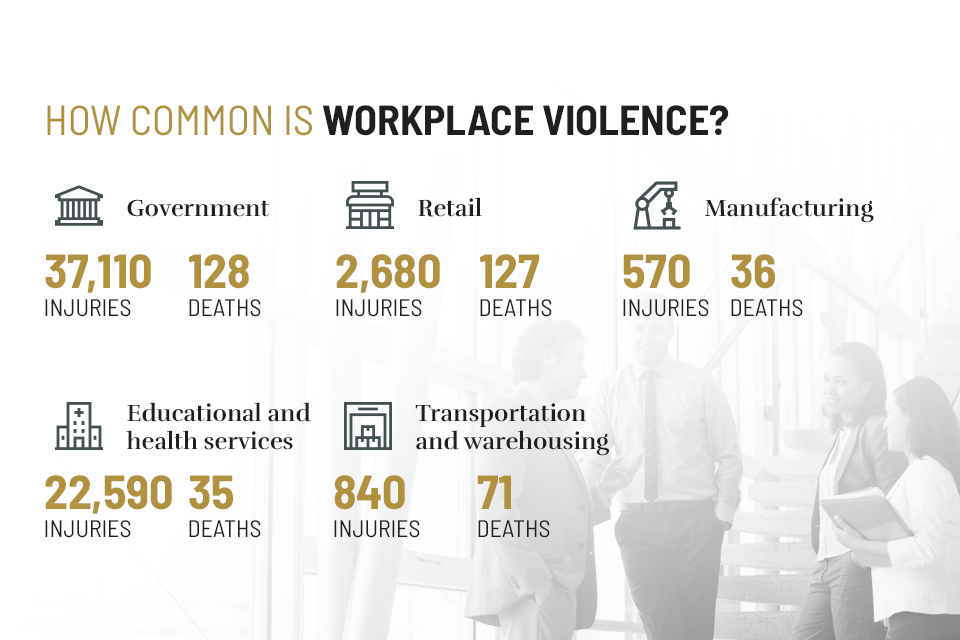Table of Contents
If you asked most people to describe violence in an everyday setting, they would probably describe a physical assault — an occasion when one person tried to hit or strike another person. Workplace violence, however, covers a much broader range. Violence in a workplace setting includes any time when a person is threatened, abused, intimidated or assaulted while on the job.

It does not need to happen on the actual job site. It can take place at a business-related function in a different location such as at a conference, trade show or exhibition.
One of the best ways to reduce workplace violence is to report it as soon as it happens to a supervisor or to your employer. If you have been a victim of workplace violence that falls under any of the descriptions mentioned above, or you see a coworker who is being assaulted in a similar way, reporting that act of violence can often prevent an even worse one from taking place.
How Common Is Workplace Violence?
According to the U.S. Bureau of Labor Statistics, about 2 million Americans a year report that they were victims of workplace violence. In 2016, 500 people died as a result of work-related violence. That means of the 5,190 work-related deaths that took place in 2016, 10 percent of them involved workplace violence. This makes work-related violence the fourth leading cause of death for American workers.
Of those 500 people who died in workplace-related accidents:
- Victims were overwhelmingly male — 82 percent were men while 18 percent were women.
- Workplace fatalities were almost 50-50 based on race, with 52 percent being individuals of color while 48 percent were white.
- The 25 to 54 age bracket comprised the largest number of fatalities at 69 percent.
- Retail workers had the highest number of fatalities at 31 percent, but police, security or correctional guards were next at 23 percent.
In some occupations, it’s even higher. For nurses, workplace violence is the third leading cause of death. And one in four nurses reports being the victim of workplace violence. Some occupations have extremely high rates of workplace violence. For instance, taxi drivers are 20 times more likely to be killed while working than any other profession, according to OSHA.
Workplace violence is a problem everywhere.
Here are a few figures regarding workplace violence including injuries that resulted in missed days of work or death from the National Safety Council’s 2013 Injury Facts report:
- Government: 37,110 injuries, 128 deaths.
- Educational and health services: 22,590 injuries, 35 deaths.
- Retail: 2,680 injuries, 127 deaths.
- Transportation and warehousing: 840 injuries, 71 deaths.
- Manufacturing: 570 injuries, 36 deaths.
Who Is at Risk of Workplace Violence?
We’ve already noted above how dangerous it is to be a taxi driver in the United States, but there are other occupations where workplace violence is also more common. Often these occupations involve certain factors that make these jobs more difficult and dangerous than others. Those factors include any job that involves:
- The transfer of money with the public, such as a clerk in a store, a taxi driver or a gas station attendant.
- Working with the public.
- Handling prescription drugs.
- Duties that include enforcement activities or inspections.
- Providing service, advice, care or education.
- Serving alcohol.
- Working alone.
- Working in small numbers or in an isolated area like a storage room or a utility closet.
- Intense organization of people, such as working during a strike or a downsizing.
These jobs include:
- Healthcare workers
- A pharmacist or in a pharmacy
- Police or firefighters
- Security or correctional guards
- Anyone who works in social services that involve counseling or crisis intervention
- Teachers
- Any kind of government inspector
- Retail workers
- Any waitstaff who serves alcohol
- Taxi drivers
- Delivery drivers
There are also times of the day or of the year and certain places where the risk of violence is increased in these occupations:
- During performance appraisals.
- During parent-teacher interviews or the issuing of report cards.
- Over the holidays.
- Working late hours at night or early hours in the morning.
- On paydays.
- When utilities are cut off because of overdue bills.
- During traffic stops.
- Working in an emergency room of a hospital.
- Giving bad news to an individual or a family in a stressful situation.
- Firing an employee.
- Anytime you’re dealing with an angry client, customer or coworker.
What Are Examples of Workplace Violence?
As we noted above, workplace violence includes more than physical assault. It’s an occasion when a worker is threatened, intimidated, abused or assaulted. It includes:
- Any behavior that might be considered threatening: Throwing an object at a person who is doing their job, shaking their fist at another person or destroying their property.
- Any form of threat that is verbal or written: Any time someone expresses an intent to harm a person at their job.
- Harassment: Any action that embarrasses, humiliates, demeans, alarms, annoys or verbally abuses a worker. This includes a variety of actions such as bullying, gestures, words or other intimidating activities.
- Verbal abuse: Insulting or swearing at a worker.
- Physical attacks: Any form of physical assault on a worker or a coworker such as pushing, shoving, kicking and striking them with a fist or some other object. The worst form of a physical attack is murder.
Workplace violence can involve customers or clients or even other coworkers.
The Center for Disease Control breaks down workplace violence in the four specific types:
1. Criminal Intent
This involves actions like robbery or assault when the perpetrator has no legitimate relationship to the worker or to their employer. It normally takes place when a crime is being committed such as robbing a bank, trespassing, breaking and entering or shoplifting.
2. Client or Customer
Known as client-on-worker violence, this is particularly a concern in the healthcare professions. Patients, their family members or visitors can assault nurses or other healthcare professionals. In a recent American Nursing Association study, 25 percent of nurses say they have been physically assaulted by a customer or client. Client-on-worker violence is also a problem in any job that involves security or retail.
3. Worker-on-Worker Violence
Sadly, this is where most people learn of workplace violence. Stories of disgruntled workers or former employees who enter their workplaces with firearms and murder or injure other workers happen fairly regularly in the United States. This type of violence is known as horizontal or lateral violence. It includes shooting incidents as well as bullying, emotional or verbal abuse that humiliates or intimidates a coworker. It is often directed at coworkers who are considered less important, such as when a supervisor continually humiliates a worker.
4. Personal Relationships
This can often involve domestic disputes or arguments that involve a perpetrator who is not connected with the business but has a relationship with a worker. One example is the man who follows his wife or ex-wife to work where he threatens or physically assaults her. This has implications not only for the worker but for any coworker who witnesses the event.
How Your Employer Should Be Protecting You
Every employer has the responsibility to protect their employees from workplace violence, whether it is from a client, customer or coworker. Employers should mandate a zero-tolerance policy towards any kind of workplace violence. This policy should provide protection for all workers associated with the business and anyone who may come into contact with it including patients, other clients, visitors to the business or contractors.
Employers need to do an assessment of their worksites and identify ways to reduce the likelihood of workplace violence. The Occupational Safety and Health Administration (OSHA) recommends putting in place a well-written workplace violence prevention program that includes administrative oversight and training for all employees.
This can take the form of a standalone workplace violence reduction program, or the employer can include it in any safety or health program, operation manual or employee handbook that is already in place. Your employer should ensure that all workers, including new hires, read and understand the policy. This includes how to report workplace violence and the consequences of workplace violence. Additional procedures may be necessary to protect employees who work in high-risk occupations and businesses.
It’s important for employees of the business to understand when their employer is not meeting the standards. This includes a lack of training, any kind of written material on a policy about workplace violence, failure to address the issue of workplace violence when an employee is hired or a lack of standards and consequences if workplace violence occurs.
Concerned employees should report any failure to address the issue to OSHA, and if they are the subject of workplace violence in a situation where their employer has done little to prevent it, they should immediately contact an attorney.
How to Report Workplace Violence
Some behaviors can indicate the potential for workplace violence. However, the presence of these characteristics does not predict that a violent act will occur as they may be indicators of other personal issues. Some indicators are:
- Problems with attendance.
- Spending an inordinate amount of time with a supervisor.
- Declines in productivity such as exercising bad judgment, making excessive mistakes and missing deadlines.
- Overreaction to criticism.
- Troubling work patterns that alternate between periods of high and low productivity.
- Problems concentrating or being easily distracted.
- Accident prone and a disregard for the safety of themselves and others.
- Bad hygiene.
- Unusual or out of the ordinary behavior.
- Signs of alcohol or drug abuse.
- Signs of extreme stress in a coworker’s personal life.
- Refusal to accept responsibility for even minor errors.
- Continual depression.
As we noted above, these may be signs of other problems, but if you notice that several of these problems are all occurring at the same time, it can be a sign of approaching trouble.
Warning signs of potential violence can usually be spotted at three levels according to the Department of Labor.
1. Early Warning Signs
You observe someone who is bullying, intimidating, disrespectful, uncooperative and is verbally abusing a coworker or you.
In this situation, you should:
- Keep a close eye on the behavior.
- Report your concerns about the situation to your supervisor and ask for their help in responding. If the offensive person is not a coworker or a fellow employee, the supervisor of the employee who reported the situation is the appropriate person to receive the report and to initiate action. If the offending person is the employee’s supervisor, however, is important for the employee to report the action to a higher level of supervision.
- It’s important to document the behavior in question.
If the offending person is not an employee, the supervisor should either speak with them about their behavior or ask them politely to leave. If the offending person is another employee, then the supervisor should meet with them to discuss concerns about their behavior. If the offending person is the employee’s supervisor, then their immediate superior should speak with them. It’s also important to identify the concerning actions and to make sure that you allow the offending employee to give their input.
2. The Situation Escalates
This involves a person who is argumentative with other customers, with sales staff, with coworkers or with management. The individual refuses to obey the company’s procedures and policies and may seek to sabotage or damage items on the business site. If this person is an employee of the business, they could be somebody who issues verbal threats or notes to coworkers or the management.
If this is the situation, it’s important to immediately contact a supervisor, and if necessary, the supervisor will contact other appropriate individuals within the company, such as security personnel or even the police. If the situation has escalated, it may be appropriate to contact 911 especially if immediate medical attention or law enforcement seem necessary. Make sure you and your coworkers and other customers are safe. It’s always a good idea at every workstation to have a list of emergency numbers for other employees.
As in the first case, do your best to document the behavior whether it is by a client or customer or a fellow employee. If the offending individual is another coworker, the supervisor should avoid dealing with the employee in public and try to resolve the situation, calling for assistance if necessary.
3. Emergency Response Required
In this case, the individual is making suicidal threats, threatening to fight staff or fellow coworkers, has engaged in property destruction, is exhibiting extreme rage or is using weapons to threaten customers or coworkers.
If you observe someone acting in this violent or threatening way who poses an immediate danger you should:
- Call 911 or appropriate security services.
- Contact your supervisor to inform them of the situation.
- Make sure you are safe.
- Make sure coworkers or customers are safe.
- If necessary, leave the area as quickly as possible.
- Follow the instructions of law enforcement as they respond to the situation.
If the event doesn’t involve another individual but a suspicious package or something you suspect is a bomb, it is extremely important that you do not touch or handle this item. You should evacuate the area immediately and then notify your supervisor of the situation. You should also call 911 and notify local law enforcement.
If You Are Concerned About Workplace Violence, Contact Frommer D’Amico
If you’ve been injured as a result of a work-related assault, either by a customer, a client or a coworker, you may be eligible for workers’ compensation. The experienced attorneys at Frommer D’Amico only work on workers’ compensation and have won millions of dollars in compensation for their clients. You should also contact us if you are worried that your employer’s inaction is making your job more difficult and dangerous and as result stress is beginning to affect your ability to do your job and enjoy your personal life.
We want to help you move forward. Give us a call at 717-428-7465 to schedule a free consultation. Or visit our contact us page where you can leave us your contact information and some details about your situation.





